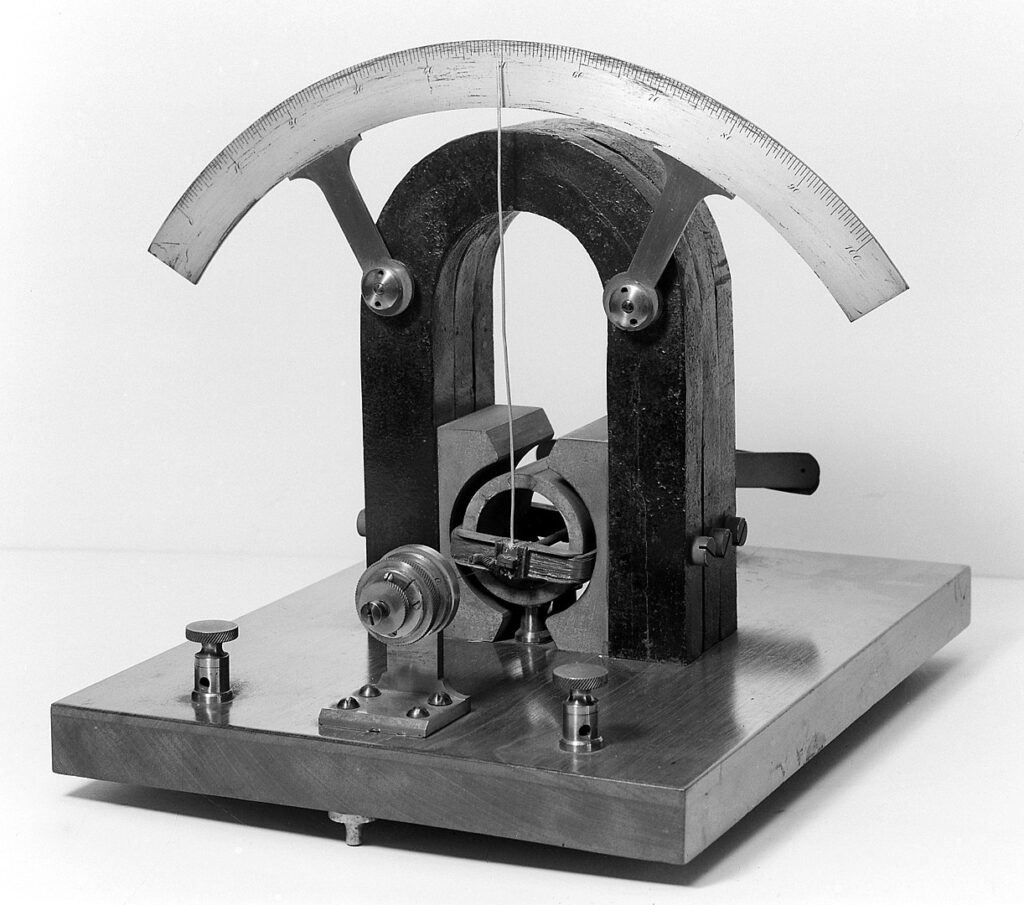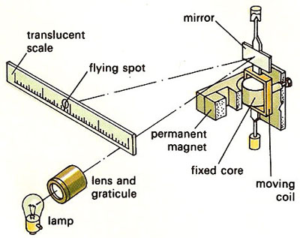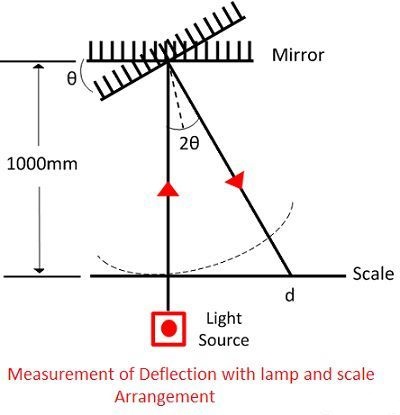Moving Coil Galvanometer is an electromagnetic device that can measure current. It consists of permanent horseshoe magnets, pivoted spring, soft iron core, coil, non-metallic frame, scale, and pointer. Moving coil galvanometers is a device which can measure even low currents of few micro-amperes.
Index
History
The deflection of a magnetic compass needle by the current in a wire was first described by Hans Oersted in 1820.
The phenomenon was studied not only for its own sake but also as a means of measuring electrical current. The earliest galvanometer was designed and reported by Johann Schweigger at the University of Halle on 16 September 1820. André-Marie Ampère also contributed to its development.
Early designs increased the effect of the magnetic field generated by the current by increasing the no. of turns of the wire.

The term “galvanometer,” was commonly used by 1836 and was derived from the surname of Italian electricity researcher Luigi Galvani, who in 1791 discovered that electric current would make a dead frog’s leg jerk.
Principle of Moving Coil Galvanometer: Torque acts on a current-carrying coil suspended in the uniform magnetic field. Due to this, the coil rotates. Hence, the deflection in the coil of a moving coil galvanometer is directly proportional to the current flowing in the coil.
Construction of Moving Coil Galvanometer
Moving Coil Galvanometer consists of a rectangular coil of a huge number of turns of thinly insulated copper wire wound over a light metallic frame.
The coil is suspended between the pole pieces of a horseshoe magnet by a fine phosphor – bronze strip from a movable torsion head to suspend the coil in a uniform radial magnetic field. The lower end of the coil is attached to a hairspring of phosphor bronze having only a small number of turns.
The other end of the spring is connected to a binding screw. A soft iron cylinder is placed symmetrically inside a coil.
The hemispherical magnetic poles produce a radial magnetic field in which the plane of the coil is parallel to the magnetic field at all positions.
A small plane mirror attached to the suspension wire which is used with a lamp and scale arrangement to measure the deflection of the coil.

Working of Moving Coil Galvanometer
Let, l, d – the length of the respective vertical and horizontal side of the coil in meters.
N – number of turns in the coil,
B – Flux density in the air gap, wb/m2
i – current through moving coil in Ampere
K – spring constant of suspension, Nm/rad
\(\bf{\theta_{F}}\) – final steady-state deflection of moving coil in radiance
When the current flows through the coil, it experiences a torque which is expressed as
Td = Force * Distance
The force on each side of the coil is given as
F = NBil
Hence deflecting torque becomes,
Td = NBild
=> Td = NBAi
Where,
A = l * d
We can then write Td as
Td = Gi
and N, B, A are the constant of the galvanometer.
Displacement constant of the galvanometer is denoted as ‘G’ , and its value is = NBA or NBld
The controlling torque exerted by the suspension at deflection θF is
Tc = KθF
For final steady deflection,
Td = TC
KθF = Gi
Hence final steady deflection,
θF = Gi/K

For the small deflection angle, the deflection is expressed as the product of the radius(distance between the centre of mirror and light source) and the angle turned by the reflected beam. It is expressed as 1000 Χ 2θF = 2000 Gi / K in millimetre.
In the above equation, 1000 is the radius i.e distance between mirror and light source and 2θF is the angle turned because mirror rotates by θF and reflected beam rotates by 2θF.
Application of Moving Coil Galvanometer
By now, I hope you understood that a moving coil galvanometer is an instrument which is used to measure electric currents. Mainly it is used for following applications:
- Detecting the current(i) in a circuit.
- To convert it into Ammeter to measure current.
- To convert it into a voltmeter to measure the potential difference.
- Detecting the direction of flow of current.
- They are used in laser engraving, laser sintering, displays like monitors and televisions.
- They are used for controlling the head positioning servos in the hard drives and CD/DVD players and music players
Advantages and Disadvantages of Moving Coil Galvanometer
Advantages
- Does not get easily affected by strong magnetic fields.
- They have a high torque to weight ratio.
- High accuracy and very reliable.
- Galvanometer also has uniform scales.
Disadvantages
- It only measures Direct currents (DC) and does not measures Alternating current quantities can not be measured
- Temperature change causes a change in restoring torque.
- During severe stresses or due to factors like aging of the instrument Phosphor bronze fiber or Helical restoring spring are susceptible to damage.
- Changing Restoring Torque is not easy.
FAQs
The ratio of the change in deflection (dθ) of the galvanometer to the change in Current(di) in a galvanometer is the sensitivity of a Moving Coil Galvanometer. Therefore, we write, sensitivity = dθ/di.
Moving Coil Galvanometer are of following types:
– Tangent galvanometer
– Astatic galvanometer
– Mirror galvanometer
– Ballistic galvanometer
– D’Arsonval galvanometer
– Weston galvanometer
– moving coil galvanometer
The major difference between ammeter and moving coil galvanometer is that ammeter shows only the magnitude of the current(i). Whereas, the moving coil galvanometer shows both the direction and magnitude of the current(i).
Most used Galvanometers are:
– Suspended coil galvanometer
– Pivoted-coil or Weston galvanometer.
